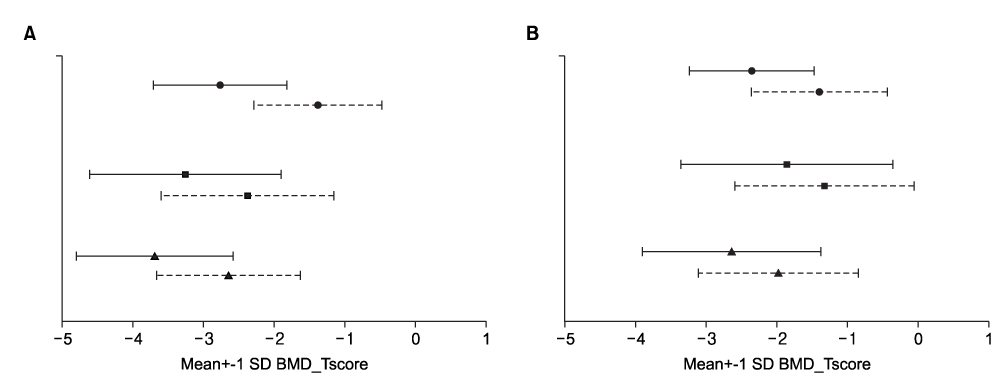J Korean Orthop Assoc.
2010 Jun;45(3):228-233. 10.4055/jkoa.2010.45.3.228.
The Relationship between Hip Fracture and Bone Mineral Density in Elderly Patients
- Affiliations
-
- 1Department of Orthopedic Surgery, Kangbuk Samsung Hospital, Sungkyunkwan University School of Medicine, Seoul, Korea. hippo@samsung.co.kr
- KMID: 2185523
- DOI: http://doi.org/10.4055/jkoa.2010.45.3.228
Abstract
- PURPOSE
The incidence of hip fracture associated with disability, pain and death increases in old age. The decreased bone mineral density, particularly due to osteoporosis, has been described as one of factors associated with the proximal femur fracture. Therefore, this study, measured the bone mineral density (BMD) of elderly patients with hip fractures to better understand the relationship between osteoporosis and proximal femur fractures. MATERIALS AND
METHODS
The bone densities of the femoral neck and trochanteric region were measured by dual energy x-ray absorptiometry (DEXA) in 60 patients with femur neck fractures and 82 patients with intertrochanteric fractures. Individuals (158 subjects) who had their BMD checked in a Health promotion center without a proximal femoral fracture were selected as a control group. The patients were divided into subgroups according to gender and type of fracture.
RESULTS
The BMD of the hip in the patients with proximal femur fractures was significantly lower than that of the control subjects. The intertrochanteric fracture group had a lower T-score than the femur neck fracture group. However the differences were not significant. No significant differences were found between the displaced and undisplaced femur neck fracture groups and between the stable and unstable intertrochanteric fracture groups.
CONCLUSION
The BMD in elderly patients with proximal femur fracture was significantly lower than that of the control group. There was a poorer association between a decreased BMD and femur neck fractures in elderly males. There were no association between the BMD and location of the fracture or fracture type.
MeSH Terms
Figure
Cited by 1 articles
-
The Stability Score of the Intramedullary Nailed Intertrochanteric Fractures: Stability of Nailed Fracture and Postoperative Patient Mobilization
Sung-Rak Lee, Seong-Tae Kim, Min Geun Yoon, Myung-Sang Moon, Jee-Hyun Heo
Clin Orthop Surg. 2013;5(1):10-18. doi: 10.4055/cios.2013.5.1.10.
Reference
-
1. Melton LJ 3rd, Wahner HW, Richelson LS, O'Fallon WM, Riggs BL. Osteoporosis and the risk of hip fracture. Am J Epidemiol. 1986. 2:254–261.
Article2. Frandsen PA, Andersen E, Madsen F, Skødt T. Garden's classification of femoral neck fractures. An assessment of inter-observer variation. J Bone Joint Surg Br. 1988. 70:588–590.
Article3. Naimark A, Kossoff J, Schepsis A. Intertrochanteric fracture: current concepts of an old subject. AJR Am J Roentgenol. 1979. 133:889–894.4. Cameron JR, Sorenson J. Measurement of bone mineral in vivo: an improved method. Science. 1963. 142:230–232.
Article5. Eastwood EA, Magaziner J, Wang J, et al. Patients with hip fracture: subgroups and their outcomes. J Am Geriatr Soc. 2002. 50:1240–1249.
Article6. Moon SH, Suh BH, Kim DJ, Kong GM, Cho HG. Comparison of bone mineral density in elderly patients according to presence of intertrochanteric fracture. J Korean Fract Soc. 2007. 20:222–226.
Article7. Smith DM, Khariri MR, Johnston CC Jr. The loss of bone mineral with aging and its relationship to risk of fracture. J Clin Invest. 1975. 56:311–318.
Article8. Newton-John HF, Morgan DB. The loss of bone with age, osteoporosis and fracture. Clin Orthop Relat Res. 1970. 71:229–252.9. Bell GH, Dunbar O, Beck JS, Gibb A. Variation in strength of vertebrae with age and their relation to osteoporosis. Calcif Tissue Res. 1967. 1:75–86.10. Carter DR, Hayes WC. Bone compressive strength: the influence of density and strain rate. Science. 1976. 194:1174–1176.
Article11. Jang J, Kim WL, Kang SB, Lee JH, Yoon KS. The relationship of osteoporosis and hip fracture in elderly patients. J Korean Hip Soc. 2008. 20:299–304.12. Kim SJ, Cho JL, Han JH, Cho SS. Relationships between Osteoprosis and Pathologic Fractures. J Korean Orthop Assoc. 1992. 27:1284–1292.
Article13. Riggs BL, Melton LJ 3rd. Evidence for two distinct syndromes of involutional osteoporosis. Am J Med. 1983. 75:899–901.
Article14. Riggs BL, Melton LJ 3rd. Involutional osteoporosis. N Engl J Med. 1986. 314:1676–1686.
Article15. Gallagher JC, Melton LJ, Riggs BL, Bergstath E. Epidemiology of fracture of the proximal femur in Rochester, Minnesota. Clin Orthop Relat Res. 1980. 150:163–171.16. Vega E, Mautalen C, Gómez A, Garrido A, Melo L, Sahores AO. Bone mineral density in patients with cervical and trochanteric fracture of the proximal femur. Osteoporos Int. 1996. 1:81–86.17. Dennison E, Mohamed MA, Cooper C. Epidemiology of osteoporosis. Rheum Dis Clin North Am. 2006. 32:617–629.
Article18. Cook PJ, Exton-Smith AN, Blocklehurst JC, Lempert-Barber SM. Fractured femurs, falls and bone disorders. J R Coll Physicians Lond. 1982. 16:45–49.19. Jahng JS, Yoo JH, Sohn JS. The relationship between the fractures of the hip and the bone mineral density over fifty years. J Korean Orthop Assoc. 1997. 32:46–52.20. Nordin BE. The definition and diagnosis of osteoporosis. Calcif Tissue Int. 1987. 40:57–58.
Article21. Mazess RB. Bone density in diagnosis of osteoporosis: thresholds and breakpoints. Calcif Tissue Int. 1987. 41:117–118.
Article22. Yoo MC, Han CS, Kin IW, Lee HK. Bone mineral density and fracture threshold in the patients with femoral neck & intertrochanteric fracture due to osteoporosis. J Korean Orthop Assoc. 1993. 28:1851–1865.
- Full Text Links
- Actions
-
Cited
- CITED
-
- Close
- Share
- Similar articles
-
- The Relationship between the Fracutures of the Hip and the Bone Mineral Density over Fifty years
- Comparison of Bone Mineral Density in Elderly Patients over 65 Years according to Presence and Types of Hip Fracture
- Risk Factors Predicting Hip Fractures in Patients Over 70 Years Old
- Usefulness of the Biochemical Markers in the Elderly Hip Fracture Patients
- The Relationship of Osteoporosis and Hip Fractures in Elderly Patients


